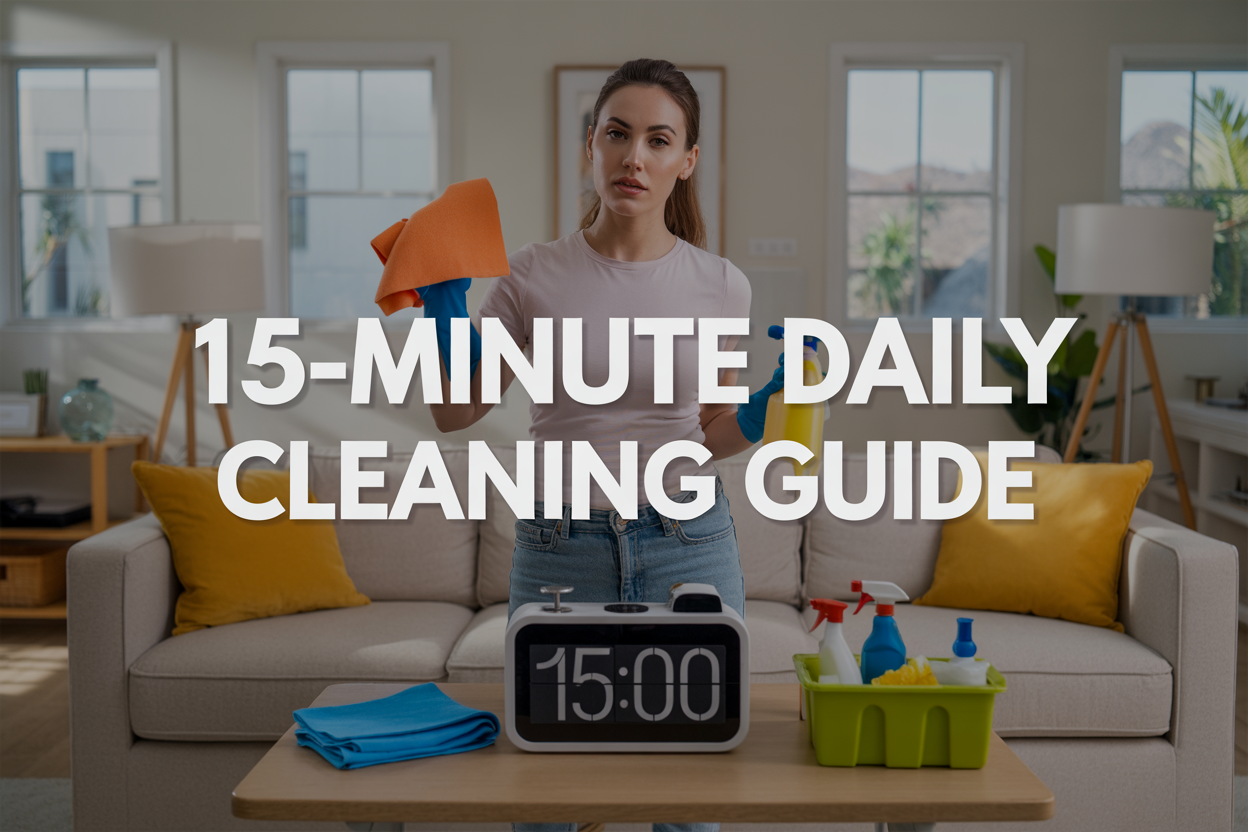
The Ultimate Guide to Daily Cleaning in 15 Minutes
Keeping a clean home doesn’t have to eat up your entire day or weekend.
This ultimate guide to daily cleaning in 15 minutes is perfect for busy parents, working professionals, and anyone who wants a tidy space without the time commitment. You’ll discover how to transform your cleaning routine from overwhelming chore to quick daily habit.
We’ll cover the essential supplies and tools that make speed cleaning possible, plus a proven 15-minute daily cleaning schedule that actually works. You’ll also learn room-by-room techniques that cut your cleaning time in half and common mistakes that steal your precious minutes.
Ready to reclaim your time while keeping your home spotless? Let’s dive in.
Essential Supplies and Tools for Quick Daily Cleaning
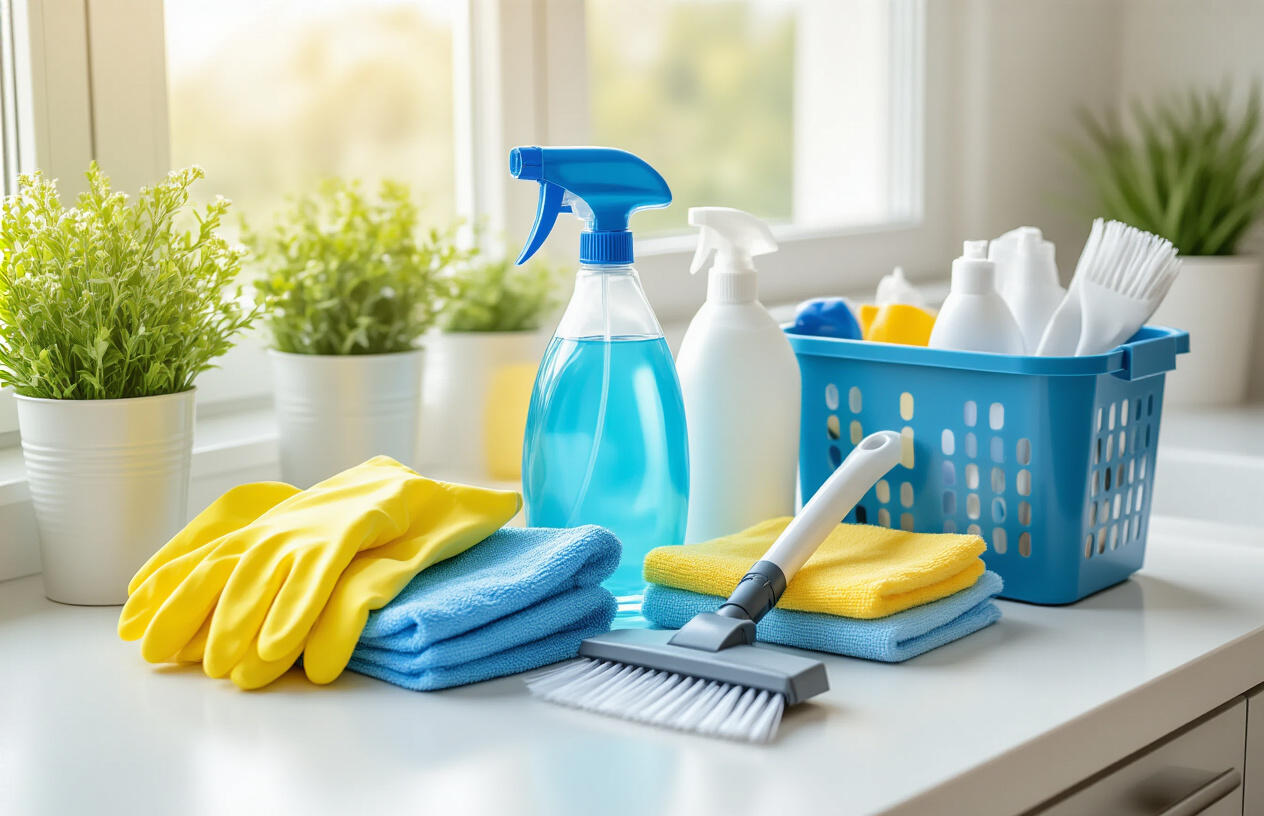
Must-have cleaning products that work on multiple surfaces
All-purpose cleaners are your secret weapon for speed cleaning. Look for products that safely tackle countertops, appliances, glass, and most hard surfaces without leaving streaks or residue. Microfiber cloths paired with these versatile cleaners can handle 80% of your daily cleaning tasks.
Glass cleaners that double as surface cleaners save precious seconds. Many modern formulations work brilliantly on mirrors, windows, stainless steel appliances, and even granite countertops. Skip the specialty products that clutter your caddy and slow you down.
Disinfecting wipes deserve a spot in every speed cleaner’s arsenal. They’re perfect for quick bathroom touchups, kitchen spills, and doorknob sanitizing. Choose wipes that kill germs while cleaning multiple surface types.
White vinegar mixed with water creates an inexpensive, effective cleaner for glass, chrome fixtures, and mineral deposits. Store this solution in a spray bottle for instant access. Baking soda tackles tough stains and deodorizes carpets when time allows for deeper cleaning.
| Product Type | Surfaces Covered | Time Saved |
|---|---|---|
| All-purpose cleaner | Counters, appliances, furniture | 5-7 minutes |
| Glass cleaner | Windows, mirrors, stainless steel | 3-4 minutes |
| Disinfecting wipes | Bathrooms, doorknobs, switches | 2-3 minutes |
Time-saving tools and equipment for maximum efficiency
Quality microfiber cloths outperform paper towels and traditional rags by trapping dirt and dust instead of pushing it around. Invest in different colors for different rooms to prevent cross-contamination without thinking twice about which cloth to grab.
A lightweight cordless vacuum designed for quick pickups transforms your cleaning routine. Models with attachments for upholstery and crevices handle stairs, car interiors, and tight spaces that eat up time with traditional vacuums.
Extendable dusters reach ceiling fans, light fixtures, and tall shelves without ladders or chairs. Look for models with bendable heads that clean around objects efficiently.
Spray bottles with adjustable nozzles control product distribution and reduce waste. Wide-spray settings cover large surfaces quickly, while stream settings target specific spots.
Rubber gloves protect your hands and improve grip on cleaning tools. Textured palms help you hold spray bottles and cloths securely, preventing drops that waste time.
A handheld scrub brush with built-in soap dispenser tackles grout, shower doors, and stubborn spots without reaching for multiple products.
Creating a portable cleaning caddy for easy transport
Your cleaning caddy should fit comfortably in one hand while holding everything needed for a complete 15-minute session. Choose a container with compartments or dividers to prevent bottles from tipping and products from mixing.
Stock your caddy with the essentials: all-purpose cleaner, glass cleaner, disinfecting wipes, three microfiber cloths (different colors), rubber gloves, and a small scrub brush. This combination handles virtually any mess you’ll encounter during daily maintenance.
Keep backup supplies in a central location but resist overloading your portable caddy. Extra weight slows you down and creates fatigue that shortens your cleaning sessions.
Consider a caddy with a handle that extends or adjusts to your height. This reduces back strain and lets you clean for longer periods without discomfort.
Add a small trash bag to your caddy for immediate debris disposal. Clipping it to the outside saves internal space while keeping your hands free for cleaning tasks.
Organize products by frequency of use. Place your most-used items in easily accessible pockets or sections. Less common tools can go in deeper compartments where they won’t interfere with your workflow.
The 15-Minute Daily Cleaning Schedule Blueprint
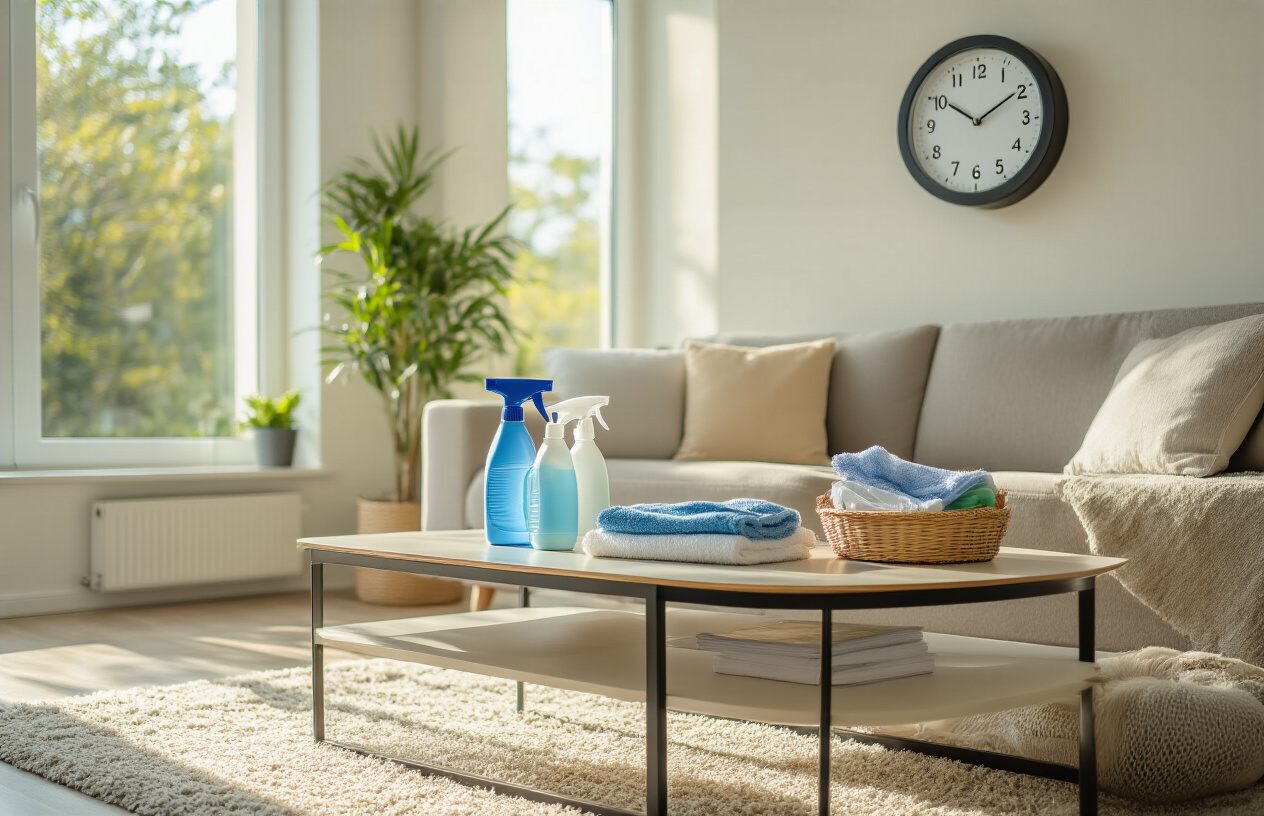
Morning 5-minute power tasks for instant home freshness
Starting your day with a quick 5-minute cleaning burst sets the tone for everything that follows. Begin by making your bed the moment you get up – this single action creates an instant sense of accomplishment and makes your entire bedroom look organized. While your coffee brews, quickly wipe down kitchen counters and load any dishes from the previous evening into the dishwasher.
Take 60 seconds to do a rapid pickup in your living space, returning items to their designated homes. This includes folding and putting away any throw blankets, fluffing couch cushions, and clearing coffee tables. The key is moving fast and focusing on visual impact rather than deep cleaning.
End your morning routine by giving your bathroom sink and counter a quick wipe-down with disinfecting wipes. These surfaces get used immediately after you wake up, so cleaning them prevents grime from accumulating throughout the day. If you have extra time, squeegee your shower walls to prevent water spots and soap buildup.
Midday maintenance habits that prevent mess buildup
Preventing messes during peak activity hours saves massive cleanup time later. The “one-touch rule” becomes your best friend – whenever you use something, put it back in its proper place immediately instead of setting it down “temporarily.” This applies to everything from mail and keys to kitchen utensils and personal items.
Implement micro-cleaning sessions between daily activities. While waiting for food to heat up, wipe down one appliance or counter section. During phone calls, walk around and tidy up visible clutter. These small actions compound throughout the day, keeping your home consistently neat.
Create a designated drop zone near your main entrance for items that typically create clutter – keys, sunglasses, packages, and daily paperwork. Having this specific area prevents these items from migrating to kitchen counters, dining tables, or other surfaces where they create visual chaos.
Evening 10-minute wind-down cleaning routine
Your evening routine focuses on resetting your home for the next day while creating a calming environment. Start in the kitchen by loading the dishwasher, wiping down all surfaces, and doing a quick sweep of the floor. Put away any items that accumulated on counters during the day.
Spend 3 minutes doing a speed pickup in common areas. Return items to their homes, fold and put away any clean laundry that’s been sitting around, and organize any paperwork or school items for the next day. This prevents morning stress when you’re looking for important documents or supplies.
Finish by preparing clothes for tomorrow and doing a final bathroom tidy. Set out your outfit, gather work materials near the door, and give bathroom surfaces one final wipe. These preparatory steps eliminate decision-making and searching during your busy morning routine.
Weekend preparation strategies for seamless weekday cleaning
Weekend prep work makes your daily 15-minute routine incredibly efficient. Spend 30 minutes on Sunday organizing cleaning supplies and ensuring they’re easily accessible throughout your home. Stock caddies with essentials for each floor or area, eliminating time spent searching for supplies during quick cleaning sessions.
Prepare grab-and-go cleaning kits for different areas. Keep disinfecting wipes, microfiber cloths, and surface cleaners in strategic locations like the kitchen, main bathroom, and bedroom areas. Having supplies within arm’s reach removes barriers to quick cleaning actions.
Use Sunday evening to reset your entire home to neutral. This means completely clearing all surfaces, putting everything in its designated place, and doing any deeper cleaning tasks that didn’t get addressed during the week. Starting Monday with a truly clean slate makes your daily maintenance routine feel effortless and effective.
Batch similar tasks together on weekends to streamline weekday routines. Do all laundry washing and folding, grocery shopping, and meal prep so your weekday evenings can focus solely on maintenance rather than major household tasks.
Room-by-Room Speed Cleaning Techniques
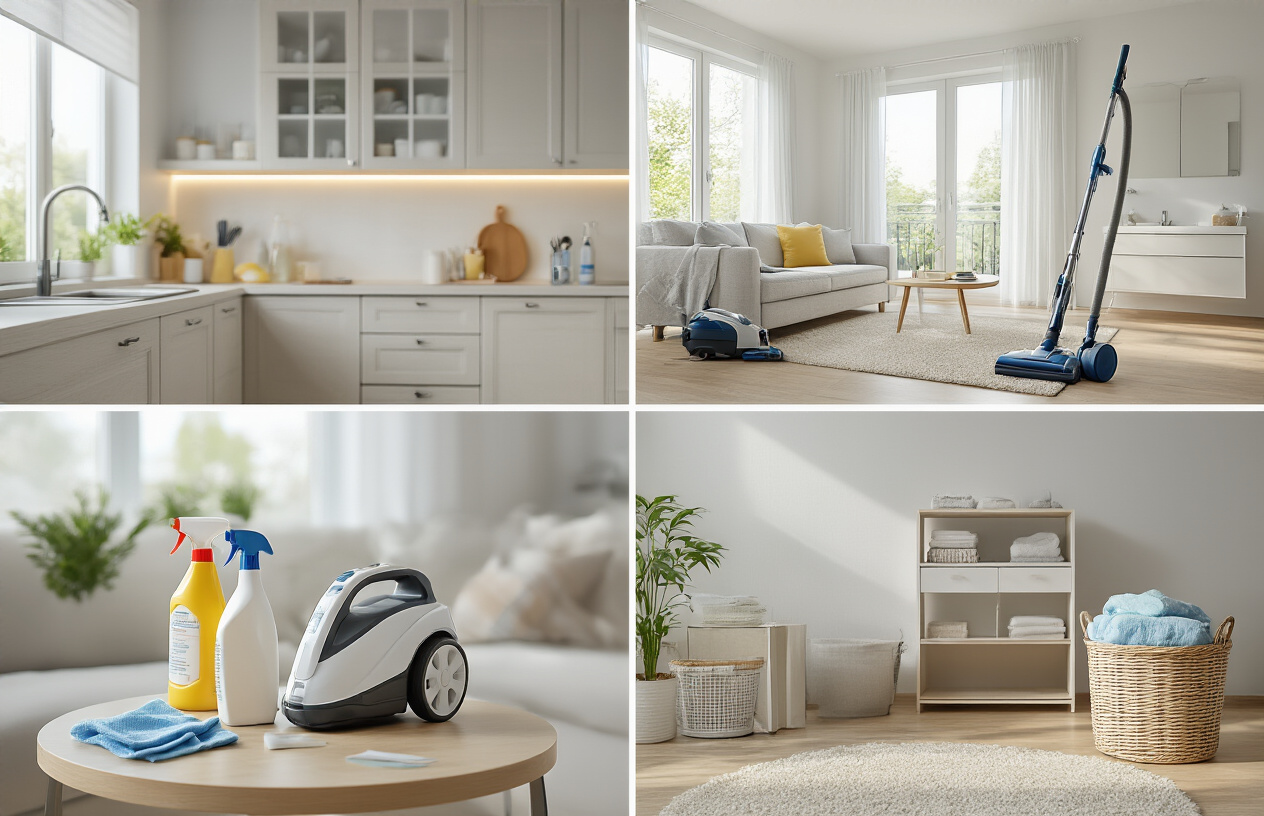
Kitchen Counter and Sink Blitz in Under 4 Minutes
Start by clearing everything off your counters and putting items back where they belong. Grab a microfiber cloth and spray your all-purpose cleaner across the entire counter surface. While that sits and breaks down grime, rinse your sink with hot water and sprinkle baking soda around the basin.
Wipe down counters with broad, sweeping motions rather than small circles. Work from back to front, pushing crumbs and debris toward the edge where you can sweep them into your hand. For your sink, scrub the baking soda with a sponge for 30 seconds, paying attention to the faucet base where buildup loves to hide.
Finish by running hot water to rinse everything away and dry the faucet with your microfiber cloth. Your kitchen will look instantly refreshed and ready for meal prep.
Bathroom Sanitizing Shortcuts That Deliver Sparkling Results
Keep a spray bottle with equal parts water and white vinegar in your bathroom for daily touch-ups. Spray your mirror, sink, and counter while you’re getting ready in the morning. The vinegar cuts through toothpaste splatter and soap residue without harsh chemicals.
For your toilet, use disinfecting wipes for a quick once-over of the seat, handle, and exterior. Drop a toilet bowl cleaner tablet in the bowl and let it work while you tackle other areas.
The shower gets the fastest treatment with a daily shower spray. Apply it right after your shower while surfaces are still warm and wet – this prevents soap scum from forming in the first place. Run your squeegee down the glass doors or shower walls to eliminate water spots.
Living Room Decluttering and Dusting Essentials
Walk through with a laundry basket and collect anything that doesn’t belong in the living room. Return items to their proper homes all at once rather than making multiple trips. Fluff couch cushions and fold throw blankets for an instantly tidier look.
Use a microfiber cloth to dust surfaces in this order: ceiling fans first, then light fixtures, shelves, coffee tables, and finally baseboards. This way, dust falls to areas you haven’t cleaned yet. For electronics and TV screens, use a slightly damp microfiber cloth to avoid scratching.
Speed vacuum high-traffic areas like in front of the couch and around coffee tables. Don’t worry about moving furniture daily – save deep cleaning for weekly sessions.
Bedroom Organization Hacks for Peaceful Spaces
Make your bed immediately after getting up. This single action transforms your room’s appearance and sets a productive tone for the day. Use the “hospital corner” technique for crisp-looking sheets that stay neat longer.
Create a “five-minute pickup” routine where you put clothes in hampers, return items to nightstand drawers, and clear surfaces. Keep a small basket on your dresser for pocket items like coins, receipts, and jewelry.
Tackle your closet floor by putting shoes back in pairs and hanging up any clothes that fell. A quick vacuum of visible floor space makes the room feel fresh without deep cleaning efforts.
High-Traffic Area Maintenance for Lasting Cleanliness
Focus your energy on entryways, hallways, and the path between your kitchen and living room. These zones get the most wear and show dirt fastest. Keep a small handheld vacuum nearby for quick crumb cleanup.
Place doormats both inside and outside entry doors to catch dirt before it spreads through your home. Shake these out weekly and spot-clean with a damp cloth as needed.
Wipe down frequently touched surfaces daily: light switches, doorknobs, cabinet handles, and remote controls. Keep disinfecting wipes in convenient locations so this becomes automatic. Pay special attention to surfaces at kid-height, which often show fingerprints and sticky spots.
Sweep or vacuum these areas every other day to prevent dirt from being tracked into carpeted rooms. A quick two-minute sweep makes a dramatic difference in your home’s overall cleanliness.
Time-Saving Strategies That Maximize Your Cleaning Impact
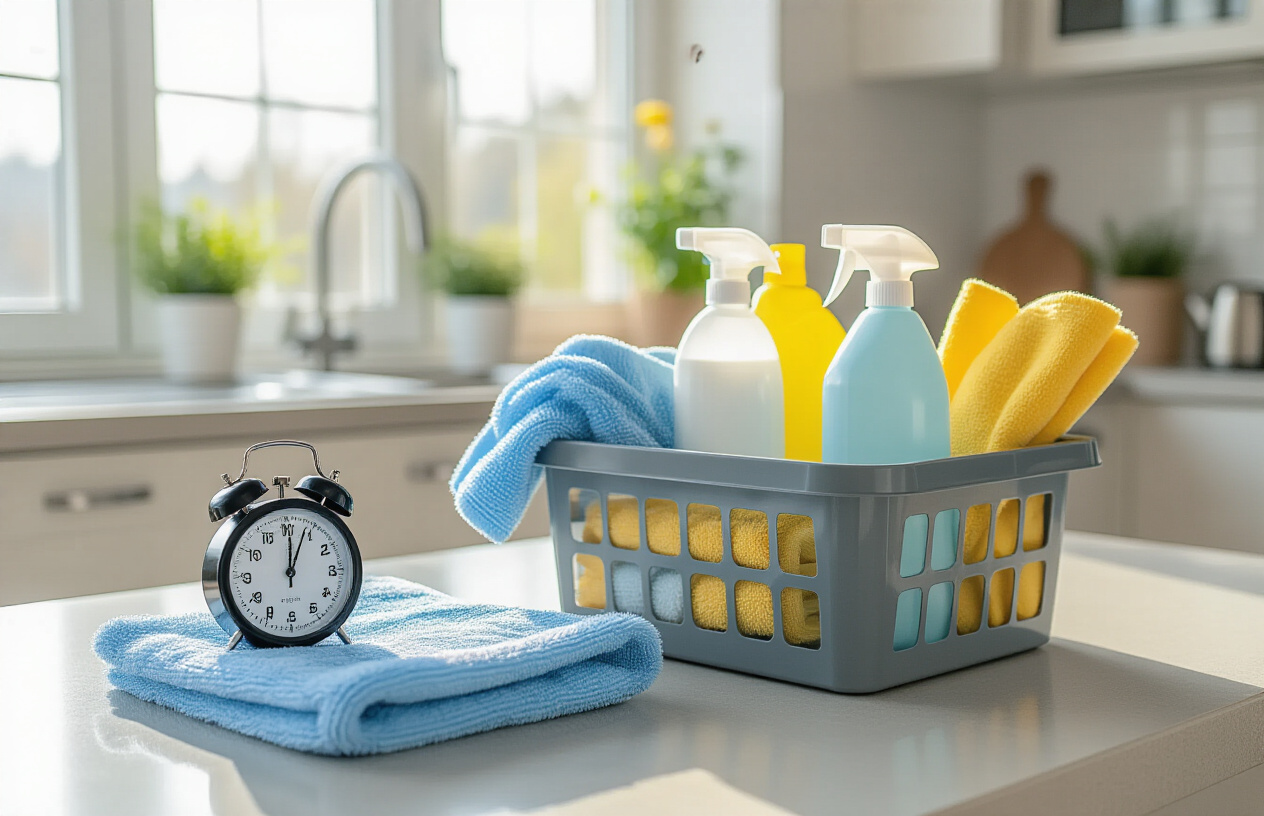
The Power of Cleaning as You Go Throughout the Day
The most effective cleaning strategy isn’t about setting aside large blocks of time—it’s about weaving small cleaning actions into your daily routine. When you clean as you go, you prevent messes from accumulating and eliminate the need for marathon cleaning sessions.
Start with your morning routine by making your bed immediately after getting up. While your coffee brews, wipe down the bathroom counter and put toiletries back in their designated spots. During breakfast preparation, wash dishes as you cook instead of letting them pile up in the sink.
Throughout your workday, practice the “reset as you leave” approach. Before moving from one room to another, do a quick 30-second scan and return items to their proper places. Keep cleaning supplies in multiple locations—bathroom wipes under each sink, microfiber cloths in the kitchen and living room—so you’re never far from the tools you need.
Evening routines benefit enormously from this approach. While dinner cooks, load the dishwasher with prep dishes. During commercial breaks or while watching TV, fold laundry or organize mail. Before bed, spend two minutes returning living room items to their homes.
This method works because it breaks cleaning into micro-tasks that feel manageable rather than overwhelming. You’ll find that maintaining a clean home becomes second nature, requiring minimal conscious effort.
Multi-Tasking Methods That Double Your Productivity
Strategic multi-tasking transforms routine activities into cleaning opportunities without adding extra time to your day. The key is identifying natural pauses and transitions in your schedule where cleaning can seamlessly integrate.
While talking on the phone, tackle light cleaning tasks that don’t require focus—dusting surfaces, organizing drawers, or wiping down baseboards. Phone conversations become productive cleaning time instead of sedentary moments. Similarly, while waiting for food to cook, use those five to ten minutes to clean nearby surfaces or organize the pantry.
Create cleaning combinations that make sense together. When you’re already in the bathroom applying skincare products, quickly wipe the mirror and counter. While waiting for laundry to finish, vacuum nearby rooms or clean out your car.
Batch similar tasks for maximum efficiency. Instead of making multiple trips upstairs throughout the day, collect items that belong upstairs and take them all at once. When you’re already on the floor playing with kids or pets, quickly wipe baseboards or pick up stray items.
Listen to podcasts, audiobooks, or music while cleaning to make the time more enjoyable and feel less like work. This psychological trick makes cleaning feel like entertainment time rather than chore time, encouraging you to clean longer and more frequently.
One-Touch Rule for Immediate Clutter Elimination
The one-touch rule revolutionizes how you handle items throughout your day, dramatically reducing clutter accumulation. Instead of moving items multiple times before putting them away, handle each object only once by immediately placing it in its designated location.
When you walk through the door with mail, don’t set it on the counter to deal with later. Sort it immediately—trash goes in the bin, bills go to your bill-paying station, and important documents go to their proper file. This prevents paper piles from forming and eliminates the need to sort through accumulated mail later.
Apply this rule to laundry by putting clean clothes directly into closets and drawers rather than creating a “clean laundry pile” on chairs or beds. When you take off clothes at night, either hang them up immediately if they’re still clean or place them directly in the hamper.
Kitchen applications are particularly powerful. After using a cutting board, wash and put it away immediately instead of leaving it on the counter. When you finish drinking from a glass, rinse and place it in the dishwasher right away. This prevents dishes from accumulating and makes your 15-minute daily cleaning much more manageable.
The rule extends to digital clutter too. When you finish reading an email, immediately delete, file, or respond to it instead of leaving it to clutter your inbox. This prevents overwhelming digital accumulation that requires significant time to address later.
Common Cleaning Mistakes That Waste Precious Time
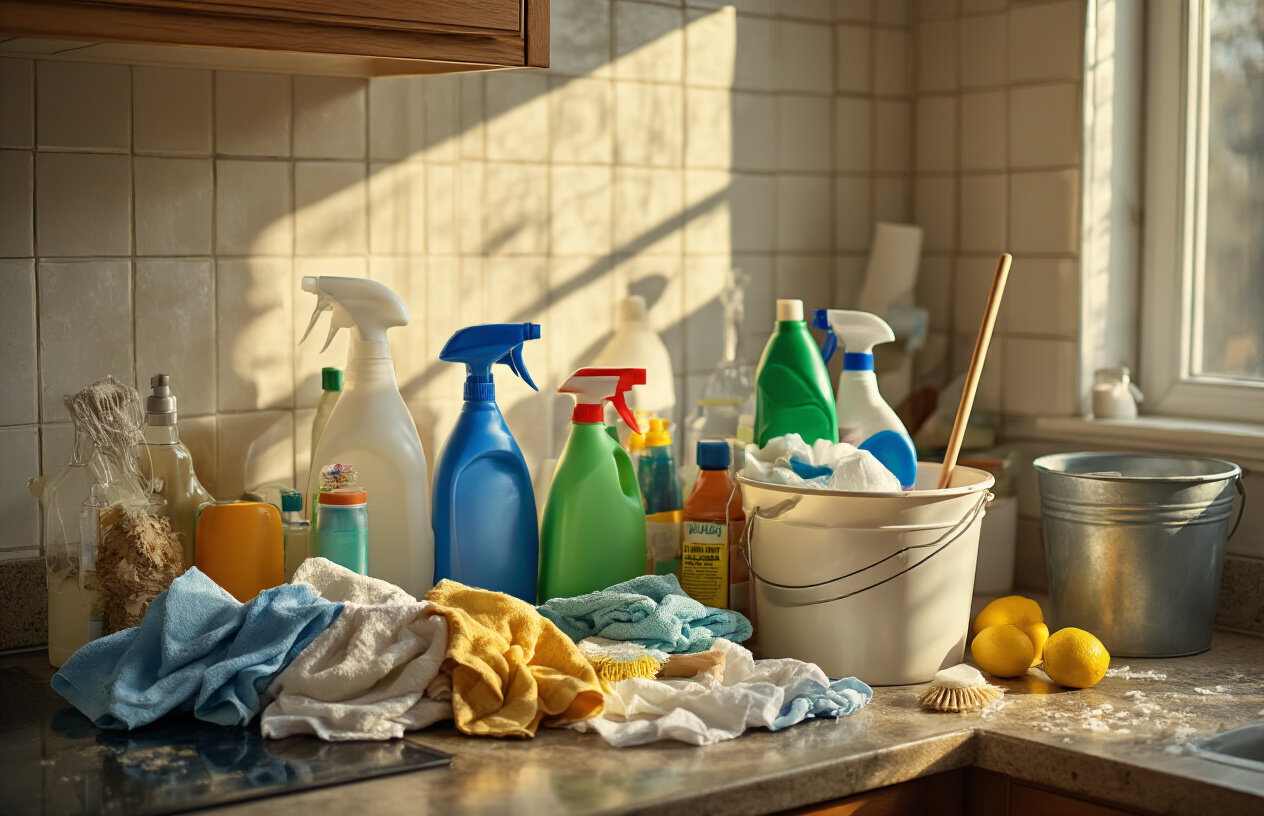
Over-cleaning areas that don’t need daily attention
Many people waste valuable minutes scrubbing baseboards, reorganizing already-tidy drawers, or deep-cleaning appliances that only need attention once a week. Your bathroom mirror might still be spotless from yesterday, yet you spend three minutes wiping it down again. The key lies in distinguishing between daily maintenance tasks and weekly deep-cleaning projects.
Focus your 15 minutes on high-traffic surfaces that actually get dirty daily: kitchen counters, bathroom sinks, and floors in main living areas. Skip dusting furniture that looks fine, washing windows that aren’t visibly dirty, or reorganizing spaces that are already functional. Save these tasks for your weekly cleaning rotation instead.
Using wrong products that create more work
The wrong cleaning product can turn a quick wipe-down into a lengthy ordeal. Glass cleaner on wood surfaces leaves streaks that require additional cleaning. All-purpose cleaner on mirrors creates smears that take extra buffing to remove. Bleach-based products on certain surfaces can cause discoloration that demands immediate attention.
Stock your cleaning caddy with versatile, appropriate products that work efficiently on their intended surfaces. Microfiber cloths paired with the right cleaner should leave surfaces clean in one pass. If you find yourself going over the same spot multiple times, you’re likely using the wrong product or technique.
Skipping preparation steps that slow you down
Walking back and forth to grab supplies eats up precious minutes from your cleaning window. Starting without a clear plan leads to wasted motion and forgotten tasks. Many people jump straight into cleaning without gathering everything they need, then spend half their time hunting for the right cloth or spray bottle.
Before starting your timer, collect all necessary supplies in a portable caddy or basket. Plan your route through the house to avoid backtracking. Clear surfaces of clutter first – trying to clean around objects takes twice as long as moving them aside initially. These 30 seconds of preparation can save you five minutes of inefficient movement.
Perfectionism traps that derail your 15-minute goal
The biggest time-waster is getting caught up in making everything absolutely perfect. You start wiping down the kitchen counter and notice a sticky spot that needs extra attention. That leads to deep-cleaning the entire backsplash, which reveals dirty grout that demands immediate scrubbing. Before you know it, 45 minutes have passed.
Set realistic expectations for your daily cleaning routine. The goal is maintaining a consistently clean home, not achieving magazine-worthy perfection every single day. If something needs deeper attention, make a note to address it during your weekly cleaning session. Your 15-minute routine should leave your home looking tidy and feeling fresh, not showcase-ready.
Remember that “good enough” daily maintenance prevents the need for marathon cleaning sessions later. A quick daily routine beats spending entire weekends deep-cleaning neglected spaces.
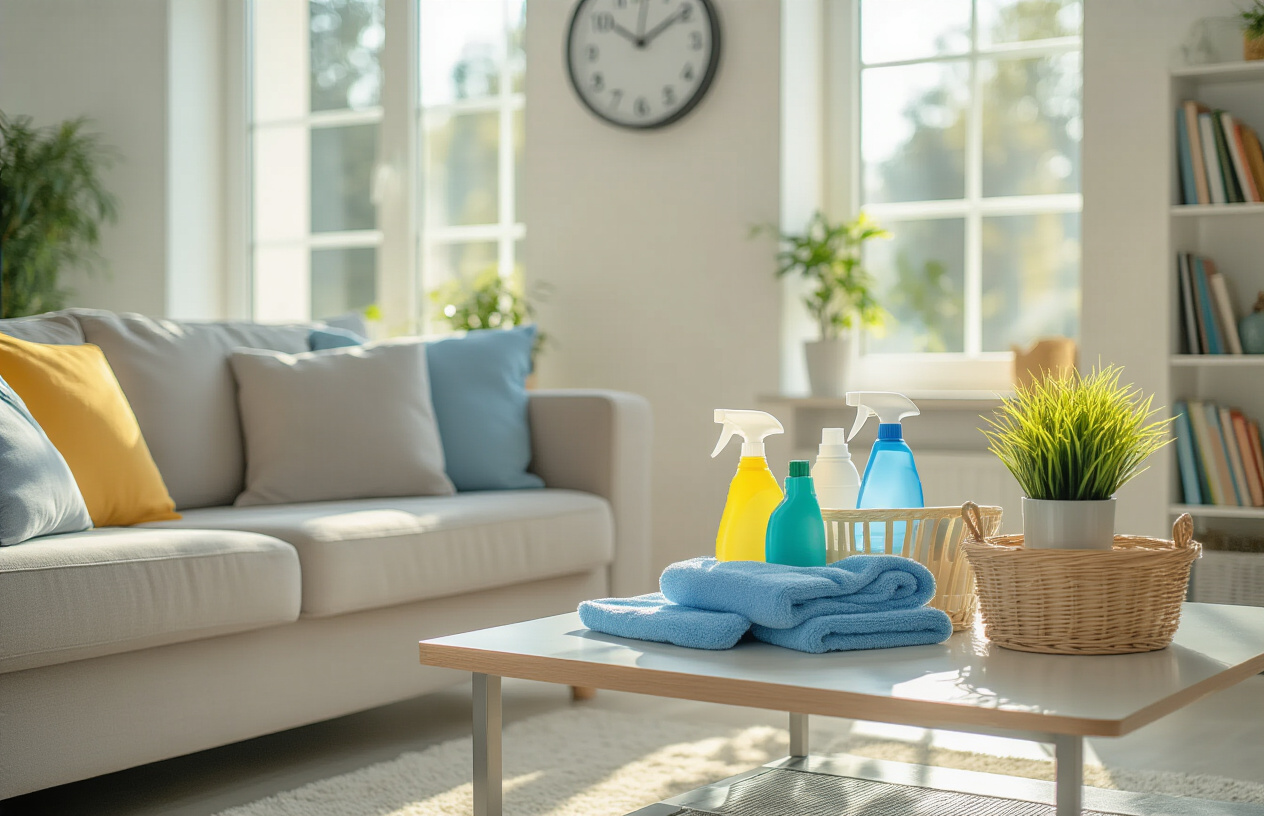
Your home doesn’t have to be perfect – it just needs to be clean enough to make you feel good walking through the door each day. With the right supplies, a simple 15-minute routine, and smart room-by-room techniques, you can stay on top of daily messes without feeling overwhelmed. The biggest game-changer is avoiding those time-wasting mistakes like cleaning windows on sunny days or scrubbing everything when a quick wipe-down would do the trick.
Start tomorrow with just one room and your timer set for 15 minutes. You’ll be amazed at how much you can accomplish when you focus on high-impact cleaning tasks instead of trying to make everything spotless. Remember, consistency beats perfection every time – a little bit every day keeps the big weekend cleanups at bay and gives you more time for the things you actually enjoy doing.
img{
width:100%;
}
table, td, th {
border: 1px solid;
}
table {
width: 100%;
border-collapse: collapse;
}










